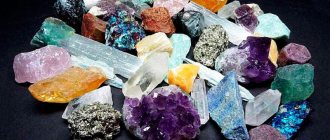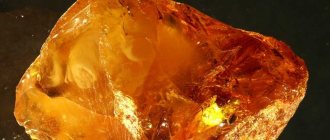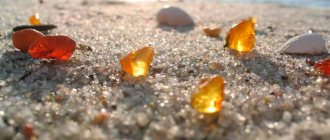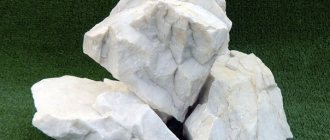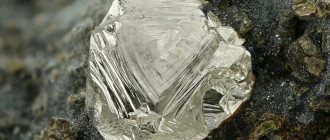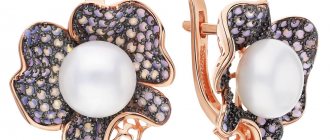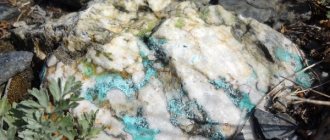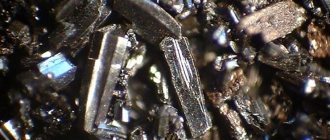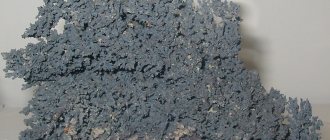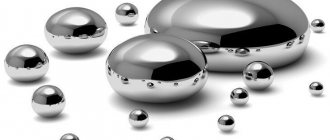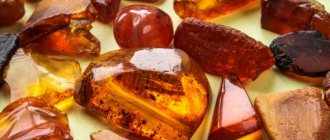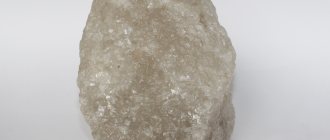MINERAL (from Late Latin minera - ore), a physically and chemically individualized, usually solid, body, relatively homogeneous in composition and properties, which arose as a product of natural physico-chemical. processes occurring on the surface and in the depths of the Earth, Moon and other cosmic. tel; usually a constituent of rocks, ores and meteorites. M. – crystalline. substances (or were previously in a crystalline state, but lost it as a result of metamict decomposition; see Metamict minerals), traditionally some natural amorphous formations (opal, allophane), as well as a few liquid ones (native mercury, amalgams) are also classified as minerals. . The vast majority of M. are inorganic. compounds, number of crystalline organic there are negligibly few compounds among M. (for example, oxalates).
Among M. there is a miner. species and their varieties. Basic taxon in mineralogical nomenclature – mineral type. When using the term "M.", as a rule, they mean the miner. view. For independent miner The species is characterized by certain chemical characteristics. composition and internal structure. Miner. varieties are variations of a single mineral. type: color, morphological, sometimes chemical. composition (without changing the crystalline structure) or structure with a constant composition. Modifications of the same composition (for example, diamond - graphite, calcite - aragonite), but having different characteristics. crystalline structure and physical properties relate to different minerals. species (the phenomenon of polymorphism). For minerals that form continuous isomorphic series (for example, olivines, wolframites, columbites; see Isomorphism), they are independent. names are assigned to the final members of isomorphic series, and the predominant chemical is considered species-forming. element (the principle is called the “50% rule”).
Total number of known miners. species approx. 4500. Opens annually approx. 60 new M. Open miner. species are approved by the Commission on New Minerals, Nomenclature and Classification of the International. mineralogical associations. M. is named after the place of the first discovery (for example, Vesuvian), in honor of famous people (lomonosovite), by color (lapis lazuli), characteristic properties (magnetite), chemical. composition (calcite), etc.
Single crystals, grains and other minerals. bodies separated from other physical bodies. interfaces are called mineral individuals. Their sizes vary over a wide range - from 1–100 nm (colloidal crystals) to 10 meters or more (crystals in pegmatites, weighing up to several tons). Miner inside. individuals in many cases, phase heterogeneity, chemical variations are observed. composition, structure and physical. properties. M. crystals often exhibit a zonal, sectorial, or block structure. Mineral intergrowths. individuals form a mineral aggregate (mono- or polymineral).
Chemical composition
In chemistry M.'s composition includes all stable and long-lived isotopes of periodic elements. system of D.I. Mendeleev, except for inert gases, which can accumulate in the structural cavities of crystalline. lattices as radiogenic products or due to capture from the external environment. The prevalence of M. is associated with the general prevalence of chemical. elements of which M. consists, and with chemical. activity of these elements. Mineral-forming role decomp. elements are not the same. Some of them tend to form their own. miner species and determine the main composition of M.; others are present preem. in the form of isomorphic impurities (so-called trace elements - $\ce{Rb, Tl, Ga, In, Ge}$, etc.), for some elements their own minerals. species unknown. Most metals are compounds of variable composition, forming two-, three-, and multicomponent isomorphic series.
Chemical composition of M., closely related to its crystalline. structure, expressed chemically. a formula compiled according to certain rules. For everyone a miner. type, an idealized formula is used, which reflects the most important features of the composition that are repeated from individual to individual, contains only elements that are present in all individuals of a given M. without exception, and secondary features of the composition are ignored in most cases. As a rule, isomorphic groups of elements (first cations, then anions) are enclosed in parentheses; elements in brackets are separated from each other by commas, while elements in greater numbers are written in 1st place. A single cation or anion is usually not enclosed in parentheses. Sometimes the valence of an element is indicated. If the ions in the structure of M. occupy different position, then they are shown separately in the formula. Additional anions ($\ce{OH^{-}, F^{–}, Cl^{–}}$, etc.) are placed after the anionic radical. At the end of the formula, crystalline hydrate water is indicated through a dot. Examples of writing formulas: gypsum, $\ce{CaSO_4·2H_2O}$; albite, $\ce{NaAlSi_3O_8}$; phlogopite, $\ce{KMg_3AlSi_3O_{10}(OH)_2}$; magnetite, $\ce{Fe^{2+}Fe^{3+}_2O_4}$; malachite, $\ce{Cu_2(CO_3)(OH)_2}$; nepheline, $\ce{(Na,K)AlSiO_4}$.
Forms of mineral isolation: 1 – calcite crystal (Sayan, Russia); 2 – twisted quartz crystal (Puyva River, Subpolar Urals, Russia); 3 – staurolite twin (Keyvy, Kola Peninsula... Photo by N.A. Pekova
In modern mineralogical systematics based on crystal chemistry. M.'s classification, which takes as a basis equally chemical. composition and crystalline structure, distinguish: 1) native elements and intermetallic. connections; 2) sulfides, sulfosalts and similar compounds (arsenides, selenides, etc.); 3) halides (chlorides, fluorides, bromides, iodides); 4) oxides (simple and complex) and hydroxides; 5) oxygen salts (nitrates, carbonates, sulfates, chromates, tungstates and molybdates; phosphates, arsenates and vanadates; borates, silicates); 6) organic salts. acids (oxalates, etc.). Silicates, as the most numerous. class M., subdivided according to crystalline types. gratings into island, chain, strip, layered and frame. The presented classification is not exhaustive and is periodically modified.
The earth's crust is dominated by aluminosilicates and silicates (especially feldspars, as well as micas, amphiboles, pyroxenes, clayey minerals, etc.); Oxides (primarily quartz), hydroxides, and carbonates (calcite, dolomite, etc.) are widespread. The total numbers of these classes make up the St. 90% of the earth's upper crust.
Human use of minerals
How a person uses minerals, you will learn from this article.
Human use of minerals
Minerals are the main components of rocks. They are widely used by humans in various areas of industrial and agricultural production. He encounters minerals at work and at home, in everyday household items, in complex scientific and technical structures, in the countryside, while eating, in nuclear power plants, and so on. Here is a list of areas where minerals are widely used by humans:
- Pyrotechnics and chemistry
Chemical preparations are made from most minerals: nitrate, native sulfur, fluorspar, potassium, boron minerals, magnesium, mercury, sodium.
- Like fertilizer
The development of agriculture is closely related to mineral fertilizers: potassium minerals (potassium salts), apatites and phosphorites (containing phosphorus), nitrogen (saltpeter).
- Chemical industry
Based on mineral raw materials. For sulfuric acid production, pyrite is widely used - pyrites rich in sulfur. For the manufacture of fire-resistant and acid-resistant materials, quartz, asbestos, and graphite are needed. In the dyeing industry, sphalerite, barite, galena, minerals of titanium, arsenic, mercury, copper, iron, cobalt, cryolite, orthoclase, boron, and zircon are used for the production of glaze and enamel. Rubber production requires talc, barite and sulfur. To produce explosives, you need saltpeter, infusorial earth and sulfur.
- Medicine and pharmaceuticals
Some minerals and products of their chemical processing are used to make medicines - mirabilite (Glauber's salt), Borzhom and Narzan (mineral waters), bismuth, boron, barium, iodine salts. Mineral springs are used for medicinal purposes: carbon dioxide, ferrous, hydrogen sulfide, salt and natural mud. Radioactive substances that are extracted from radioactive minerals are also used in medicine. Minerals such as sassolin, colemanite, magnesite, and gypsum are valuable for medicine.
- Metallurgy and construction
Minerals are also used in metallurgy, such as rhodochrosite, vanadinite, dolomite, colemanite. Without gypsum, dolomite and calcite, it would be impossible to build buildings.
- Jewelry
Minerals used by humans in jewelry are divided into precious and ornamental stones. This is the widest scope of their application. Even in Ancient Egypt, golden figures of birds were made with inserts of malachite, amazonite, chrysolite, rock crystal and carnelian serpentine. In China, green or white jade stone was especially popular, from which jewelry, amulets, signs of the king’s power, figurines and writing instruments were made.
Today, garnets, sapphire, amethysts, topaz, chalcedony, jasper, carnelian, chrysoprase, lapis lazuli, heliodor, agate, onyx, aquamarine, emerald, citrine, gold, platinum, tourmalines, diamonds, and opals are used in jewelry.
We hope that from this article you learned how a person uses minerals.
Physical properties
Chemical composition and crystalline structure is determined by physical properties of M. These include: density, optical, mechanical, luminescent, magnetic, electrical, thermal. and other properties, radioactivity. Based on density, metals are divided into light (up to 2500 kg/m3), medium (2500–4000 kg/m3), heavy (4000–8000 kg/m3) and very heavy (over 8000 kg/m3). Among optical properties - color, shine (there are metallic, semi-metallic, diamond, glass, greasy, pearlescent, silky, etc.), degree of transparency (M. are divided into transparent, translucent, translucent and opaque), light refraction and reflection, pleochroism, etc. Mechanical properties include hardness, elastic properties (fragility, malleability, etc.), cleavage, fracture (the nature of the split surface that did not occur along the cleavage - stepped, splintered, conchoidal, etc.). Hardness of metal - resistance of material to external mechanical influences. exposure to another, more solid body; Depending on the test method, the hardness of scratching (the most common method of scratching using the standard M. Mohs scale), indentation, and grinding is distinguished.
Beautiful and dangerous
When heated, a crystal like a stone emits a gas dangerous to human health - radon. Poisonous gas may cause lung cancer. Radioactive elements, affecting immune and hematopoietic cells, lead to the development of various types of diseases.
Read also: Interesting facts about teeth, structure, classification, names
Stibnite is considered an equally toxic antimony sulfide mineral. This hard and fragile stone in the form of needle-shaped crystals with a slight iridescent tint and silvery sheen can cause severe poisoning when in contact with the skin. Just 100 mg of Sb in the human body can become a lethal dose for it.
Chalcanthite is another incredibly beautiful, but quite dangerous stone, which is formed from short prismatic crystals of bright blue, sky blue or greenish turquoise. This stone is also called the “copper flower”, and upon contact with liquid it releases toxic substances that become a threat to the life of all living things. If you throw a small blue stone into a pond, you can kill life in the entire pond.
Morphology
The form of M.'s secretion depends on their internal. structure and conditions of education. Crystallic. the structure determines M.'s belonging to the class. crystallographic syngony and symmetry class, which determine the shape of crystals. When describing the appearance of crystals, the terms “appearance” are used (describes the ratio of crystal sizes in different directions, for example, isometric, elongated, flattened) and habit (characterizes the shape of crystals in more detail, reflecting the predominance of certain faces of simple shapes - cubes, octahedrons, prisms, etc.). When decl. Under the conditions of formation, crystals of the same crystal may have different characteristics. appearance and habit. Rapid crystallization of M. leads to distortion of the shape of their crystals, the appearance of skeletal, dendritic, thread-like forms, and spherocrystals. M. crystals often have characteristic shading on their faces, figures of growth and dissolution. Mass crystallization (for example, during the formation of intrusive rocks) creates an environment of constrained growth, and M. forms grains of irregular shape.
Much more often than dep. M. crystals, their intergrowths and aggregates are found. For crystals pl. M. is characterized by regular accretion: twins (often polysynthetic), parallel and epitaxial intergrowths, etc. According to the morphology of the miner. aggregates are divided into drusen, brushes, dendrites; granular, dense and earthy masses, oolites, spherulites, secretions, concretions, sinter formations, etc.
Native elements
These are minerals (photos can be seen below) that are formed by simple substances. For example:
- gold in the form of sand and nuggets, ingots;
- diamond and graphite are allotropic modifications of the carbon crystal lattice;
- copper;
- silver;
- iron;
- sulfur;
- group of platinum metals.
Often these substances occur in the form of large aggregates with other minerals, pieces of rock and ores. Extraction and their use in industry are important for humans. They are the basis, the raw material for obtaining materials from which a variety of household items, structures, decorations, devices, etc. are subsequently made.
Diagnostics
Phys. properties, chemical composition and morphological M.'s features are the basis for their diagnosis, searches, and, in some cases, practical. applications. Preliminary field diagnostics of M. is carried out according to external signs, morphology of secretions, hardness, density, line color (color of M. in powder), luster, tarnish, cleavage, fracture, luminescence, magnetism, etc. In laboratory conditions, optical research is carried out. properties of metal under a microscope (in transparent sections, polished sections, immersion preparations). Accurate diagnosis is carried out based on the determination of chemical. composition and crystalline structures of minerals. In the study of minerals, methods such as X-ray diffraction analysis, electron probe microanalysis, electron microscopy, IR spectroscopy, atomic absorption analysis, etc. are widely used (see Mineralogy).
The healing properties of gems: myth or reality
It has long been believed that rocks have the ability to relieve diseases, bring money and good luck, and attract love. There is interesting evidence that stones have magical properties.
And now minerals are correlated with the signs of the Zodiac, I recommend choosing “your” stone.
Useful information on how to choose and wear stones correctly
Those born in spring can choose such precious stones as: green diamond, sapphire, emerald, amethyst, peridot and pink topaz.
People born in summer need strong protection, which will be provided by aquamarine, ruby, emerald, garnet, zircon, pink topaz and chrysoberyl.
Those born in autumn can opt for topaz, garnet, sapphire, adamantium and peridot.
A person born in winter most often has an unyielding and firm character, but sometimes personal success is not enough for such people. Amulets and talismans made of crystal, diamond, turquoise, quartz, sapphire and moonstone can combat this problem.
Two weeks after purchasing the stone, the mineral is not used for its intended purpose, but it is worth communicating with it: praising, stroking and talking.
You cannot wear or use cracked gem jewelry that has been damaged by mechanical impact. If it is amber with a natural defect, then it is permissible to use it.
Genesis
The concept of “genesis of M.” includes the following characteristics: geological. conditions and geochemical conditions for the occurrence of minerals, the phase state of the mineral formation environment, its physico-chemical. parameters (temperature, pressure, activity of components, oxygen potential, basicity-acidity regime, etc.); the mechanism of the origin, growth and development of microorganisms, in particular the method of formation (free crystallization, metasomatic development, recrystallization, decrystallization of gels, etc.); processes of subsequent change, etc.
M. arise in various geological conditions and geochemical situations in connection with the processes of magmatism, metamorphism, metasomatism, volcanic. and hydrothermal activity, with the processes of sedimentation and their subsequent transformation (diagenesis, catagenesis, metagenesis), in the weathering crust, the oxidation zone of ore deposits, etc. In a certain area of the earth’s crust, several minerals are usually present, which form mineral associations. Naturally formed during a single process, limited in space and time and occurring in certain physical and chemical conditions. conditions, associations are called M. paragenesis (paragenetic associations). Since natural processes occur under conditions of changing temperature, pressure and concentration of components, during their development only paragenetic. M.'s associations are naturally replaced by others. Paragenetic analysis makes it possible to predict the presence of M. in a particular association, as well as to identify various. stages of the mineral formation process. M. is often found in the field in different paragenetics. associations, i.e. M was formed at different stages of deposit formation. Such separations of the same material at different times are called generations.
The origin of M. can occur in different conditions. according to the phase state of the media: solid (during metamorphism), liquid (from a melt during the process of magmatism, from hot aqueous solutions in hydrothermal conditions, from sea water in the sedimentary process), gaseous (during volcanism). During the growth process, M. interacts with the mineral-forming environment, while it captures decomposition. impurities that enter it isomorphically or in the form of mechanical, gas-liquid, melt and other inclusions.
When changing physical and chemical situation (change in temperature, increase in pressure, influx of new solutions, etc.), mechanical phenomena sometimes occur. deformation, dissolution, polymorphic transformations, decomposition of solid solutions, recrystallization, chemical changes. composition of M., etc. At each stage of the process of mineral formation, M. acquires specificity. typomorphic features (see Typomorphism of minerals).
To determine the genesis of M., in addition to observing geological living conditions, paragenetic analysis, study of inclusions, identification of typomorphic features, carry out thermodynamic calculations. characteristics and experiments. modeling of possible natural processes of formation, isotope analysis, etc. Obtaining data on the genesis of minerals allows one to reconstruct the geological. processes and history of the formation of mineral deposits, which creates scientific. the basis for their searches, exploration and industrial activities. assessments.
Interesting facts about minerals
- At the site of the lightning strike, a hollow tube is formed, coated on the inside with the newly formed mineral fulgurite. Such a tube can be up to several meters long. But it is very difficult to extract fulgurite due to its fragility.
- The world's largest crystal crystal was found in Kazakhstan. It is the size of a two-story house and weighs 70 tons.
- The well-known jade is twice as strong as steel.
- Minerals are found not only on Earth. For example, the recently discovered tranquilityite was found in the Sea of Tranquility, which is located on the Moon.
Application
15–20% of all known minerals are used in technology and industry. species. M. are ores of ferrous and non-ferrous metals, rare and trace elements, and minerals. fertilizers, raw materials for chemicals. industry, etc. M. are widely used in the production of dyes, refractories, heat insulators, and construction. materials, in ceramics prom-sti, etc. A number of M. are jewelry and ornamental stones. Application of plural M. is based on their physical. properties: hard metals (diamond, corundum, etc.) are used as abrasives; M. with piezoelectric. properties (for example, quartz) - in radio electronics; electrical insulating metals (including mica) - in electrical and radio engineering, etc. Samples of metal with high decorative properties (crystals, druses, etc.) have museum and collection value, and are also used for decorating interiors. Metal synthesis is carried out on a large scale for the needs of industry, technology, and science.
Phosphates, arsenates, vanadates
This group includes rocks and minerals that are predominantly exogenous in origin, that is, found in the outer layers of the earth’s crust. Only phosphates are formed inside. There are actually quite a lot of salts of phosphoric, arsenic and vanadic acids. However, if we consider the overall picture, then in general their percentage in the bark is small.
There are several of the most common crystals that belong to this group:
- apatite;
- vivianite;
- lindakerite;
- rosenite;
- carnotite;
- Pascoite.
As already noted, these minerals form rocks of quite impressive size.
Types of classification of natural stones and minerals
Minerals are identified by their place of origin, composition and structure. In order to separate valuable specimens from decorative stones, a classification of natural specimens was invented according to common characteristics and differences.
Scientists and philosophers have been developing it for a long time. Today there are several techniques that gemologists use. The most popular of all existing types is considered to be the classification of natural stones and minerals by Kluge and Bauer. The German researcher Kluge divided raw materials into 5 groups. The first three were dedicated to precious samples.
Bauer's version was replenished with jewelry and semi-precious stones. Mineralogist Fersman diversified the document by dividing the types of precious stones into classes. The changes made by the scientist Kievlenko concern price and application. The latest edits were made by Melnikov, who proposed a classification of precious crystals into 3 varieties.
The development of jewelry making in the USSR, which occurred in the second half of the 20th century, forced the creation of a unified industrial methodology. It is still successfully practiced today.
Carbonates
This class of minerals includes a fairly wide variety of representatives, which also have important practical significance for humans. So, there are the following subclasses or groups:
- calcite;
- dolomite;
- aragonite;
- malachite;
- soda minerals;
- bastnäsite.
Each subclass includes from several units to dozens of representatives. In total there are about one hundred different mineral carbonates. The most common of them:
- marble;
- limestone;
- malachite;
- apatite;
- siderite;
- Smithsonite;
- magnesite;
- carbonatite and others.
Some are valued as a very common and important building material, others are used to create jewelry, and others are used in technology. However, all are important and are being mined very actively.
ZINC (Zn)
Zinc is an essential mineral that is involved in a wide range of cellular metabolic processes. It is a catalytic factor for approximately 100 enzymes and is essential for normal immune function, protein synthesis, wound healing, nuclear and mitochondrial DNA synthesis and maintenance, and is vital for cell division, growth and development. Zinc is also necessary for proper taste and smell.
Zinc is widely found in many foods, especially oysters, while red meat and poultry also provide significant levels of zinc and provide most of the zinc in the normal diet. Significant levels of zinc are also found in other food sources, such as beans, nuts, shellfish (crab and lobster), whole grains, fortified breakfast cereals and dairy products, although high levels of phytates in grains, legumes and nuts may bind to zinc and reduce bioavailability.
Zinc deficiency has been associated with the following symptoms and signs: Acne, anorexia, loss of taste, eczema, glucose intolerance, diabetes, apathy, fatigue, depression, hyperactivity in children, impaired protein synthesis: hair loss, poor wound healing, skin stretch marks, soft or brittle nails, recurrent infections, white spots on the nails, growth and development disorders: short stature, delayed puberty, impotence, irregular menstruation.
Additional dosage: 10 - 30 mg per day. NOTE: Long-term use of high doses may cause copper and iron deficiency.
Rich natural sources: oysters, fish (sardines, herring), meat, liver, milk, seeds, wheat germ, onions, mushrooms, yeast, whole grains, nuts, peas, carrots, vegetables.
Signs of toxicity: nausea, vomiting, diarrhea, drowsiness, increased sweating, alcohol intolerance. May cause copper and/or iron deficiency. May cause seizures in people with epilepsy.
Microminerals (Trace Elements)
The body needs trace elements in very small quantities. Note that iron is considered a trace mineral, although the amount needed is slightly higher than for other trace minerals.
| MINERAL | FUNCTION IN THE BODY | SOURCES |
| IRON | A component of hemoglobin - found in red blood cells that carry oxygen in the body; necessary for energy metabolism | By-products; red meat; fish; bird; shellfish; egg yolks; legumes; dried fruits; dark leafy greens; iron-fortified breads and cereals; fortified cereals |
| ZINC | Part of many enzymes; necessary for the production of protein and genetic material; has the function of taste perception, wound healing, normal fetal development, sperm production, normal growth and puberty, immune system health | Meat, fish, poultry, whole grains, vegetables |
| IODINE | Contained in thyroid hormone, which helps regulate growth, development and metabolism | Seafood, foods grown in iodine-rich soil, iodized salt, bread, dairy products |
| SELENIUM | Antioxidant | Meat, seafood, grain |
| COPPER | Part of many enzymes; necessary for iron metabolism | Legumes, nuts and seeds, whole grains, organ meats, drinking water |
| MANGANESE | Part of many enzymes | Widely distributed in foods, especially plant foods |
| FLUORINE | Participates in the formation of bones and teeth; helps prevent tooth decay | Drinking water (fluoridated or naturally containing fluoride), fish and most teas |
| CHROMIUM | Works closely with insulin to regulate blood sugar (glucose) levels | Unprocessed foods, especially liver, brewer's yeast, whole grains, nuts, cheeses |
| MOLYBDENUM | Part of some enzymes | Legumes; bread and cereals; greenery; leafy, green vegetables; milk; liver |
Other trace minerals that are needed in tiny quantities include: nickel, silicon, vanadium and cobalt.
Macrominerals (Macroelements)
| MINERAL | FUNCTION IN THE BODY | SOURCES |
| SODIUM | Essential for proper fluid balance, transmission of nerve impulses and muscle contraction | Table salt, soy sauce; large amounts in processed foods; small amounts in milk, bread, vegetables and unprocessed meats |
| CHLORINE | Necessary for proper fluid balance and stomach acid production | Table salt, soy sauce; large amounts in processed foods; small amounts in milk, meat, bread and vegetables |
| POTASSIUM | Essential for proper fluid balance, transmission of nerve impulses and muscle contraction | Meat, milk, fresh fruits and vegetables, whole grains, legumes |
| CALCIUM | Important for healthy bones and teeth; helps muscles relax and contract; important for the functioning of the nervous system, blood clotting, blood pressure regulation, immune system health | Milk and dairy products; canned fish with bones (salmon, sardines); fortified tofu and fortified soy milk; greens (broccoli, mustard); legumes |
| PHOSPHORUS | Important for healthy bones and teeth; found in every cell; part of the system that maintains acid-base balance | Meat, fish, poultry, eggs, milk, processed foods (including carbonated drinks) |
| MAGNESIUM | Found in bones; essential for protein production, muscle contraction, nerve transmission, immune system health | Nuts and seeds; legumes; leafy, green vegetables; seafood; chocolate; artichokes; "hard" drinking water |
| SULFUR | Needed for the formation of protein molecules | Found in food products as part of protein: meat, poultry, fish, eggs, milk, legumes, nuts |
Age
Scientists and geologists determine the age of rock minerals using two scales.
Relative
The age of rocks is determined relative to each other: some are younger, some are older.
This is determined by stratigraphic or paleontological methods:
- The stratigraphic method involves studying the relative position of layers. But only if no movement due to tectonic processes has been observed over millions of years. That is, there was no destruction of the layers, their sequence was preserved. In this case, the higher the layer, the younger the rock. In the very top layers she is the youngest.
- The marker of the paleontological method is fossil organic remains. It has been established that coeval layers contain remains of the same plant or animal species.
Both methods take as a basis the location of rock layers in the earth's crust.
Absolute
The exact age of the deposits is determined by the state of the radioactive elements in the composition.
The degree of decay of radioactive elements is known precisely; it has a constant rate that is not affected by external disasters. This makes it possible to determine the age of the rock with an accuracy of hundreds of years.
Commonly used are uranium-235 or 238, thorium-232, and carbon-14.
The choice of isotope depends on the expected age of the rock:
- For material younger than 50 thousand years (for example, peat), this is an isotope of carbon.
- Isotopes of uranium, lead, thorium, potassium, and samarium are suitable for rocks older than 3.5 billion years.
- Rubidium-strontium, uranium-lead material is applicable to samples aged from one hundred million to five billion years.
To determine age, the ratio of the mass of the newly formed element to the mass of the radioactive isotope used is calculated.
Place of Birth
Rocks are the basis of the earth's crust, almost all of their deposits are of industrial importance.
They are classified according to several criteria:
- Type of raw materials. Ore, non-metallic, combustible (hydrocarbons, shale, coal, peat), hydromineral (water).
- Geological structure. Simple, complex, especially complex. The basis is the condition of the layers and the uniformity of occurrence.
- Depth. Depending on it, raw materials are extracted in an open (quarry) or closed (mine) way.
Production volumes are measured in millions of tons, and the price is almost always set per ton. The exception is radioactive and decorative materials. For example, Carrara marble.
MANGANESE (Mn)
Manganese is essential for bone formation and energy metabolism. It is also a constituent of an antioxidant enzyme that helps prevent cell damage caused by free radicals.
Deficiency : Manganese deficiency is rare.
Side effects : Manganese toxicity is not a problem because its blood levels are closely monitored.
Nutrition Sources : It is present in plant foods such as vegetables, grains and nuts. Tea is also a rich source. In most regions of the planet, manganese consumption comes from cereals and grain products.
What are natural stones made of?
Natural pebbles amaze with their diversity of composition. Surprisingly, most are based on one of two substances that affect their properties:
- Silicon or silicates. They demonstrate high strength, density, and resistance to temperature fluctuations.
- Calcium carbonate. Minerals formed from this compound are friable and resistant to acids and alkalis. They came from the remains of plants and animals compressed by time.
In addition to stones with the usual chemical composition, there is a miracle born in the depths of the earth to surprise and delight. This is a diamond. This unique creation contains only one element – carbon.
Yakut diamonds are called the kings of gems
